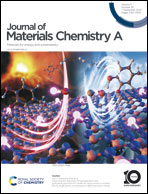Designing n-type all-ionic thermoelectric polymers with improved air stability via a solution-processing anion exchange technique†
Abstract
Current thermoelectrics technologies are dominated by inorganic materials that can efficiently harvest low-grade waste heat and realize electrical energy conversion; however, their toxicity, rigidity, rare element-based compositions and energy-intensive processing limit their wide applications. Organic thermoelectrics, with the advantages in mechanical flexibility, material abundance and low-temperature/pressure processing, offer solutions to resolve these limitations. Among organic thermoelectrics, the less well-studied ionic polymers possessing intrinsically high Seebeck coefficients are beneficial for charging supercapacitors or batteries, and hence motivated the present study. Its main purpose is to design and develop air-stable n-type all-ionic thermoelectric polymers with suitable ionic conductivity and high Seebeck coefficients. Our initial focus was on two commercially available, water-processable Cl− based cationic polyelectrolytes, polydiallyldimethylammonium chloride (PDADMAC) and poly(2-(dimethylamino)ethyl methacrylate) methyl chloride quaternary salt (MADQUAT); however, their instability to moisture led to transient, irreproducible Seebeck coefficients. To tackle this challenge, which is in fact quite common among n-type ionic polymers, we adopted a facile, solution-based anion exchange technique by replacing the smaller and unstable Cl− ions with bulkier, more hydrophobic tetrafluoroborate (BF4−) and hexafluorophosphate (PF6−) ions in the polymer systems. We also conducted comparative experimental studies of the thermoelectric behaviors of post-anion exchanged polyelectrolytes under dry (15% relative humidity) and more humid (40% relative humidity) atmosphere. Results have confirmed that the thermoelectric properties of the post-exchange systems are humidity-dependent. In particular, BF4−-based MADQUAT and PF6−-based PDADMAC showed good ionic conductivity, reliable, reproducible Seebeck coefficients and outstanding power factors at 40% relative humidity with significant improvement in air stability. This opens up opportunities for the further development of all-ionic polymer systems to be applied in a variety of applications, such as sensors, storage, wearable electronics, and batteries.

- This article is part of the themed collection: Celebrating International Women’s day 2024: Women in Materials Science


 Please wait while we load your content...
Please wait while we load your content...